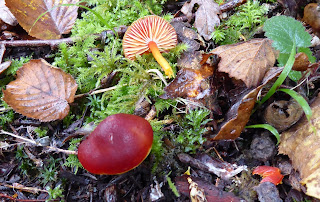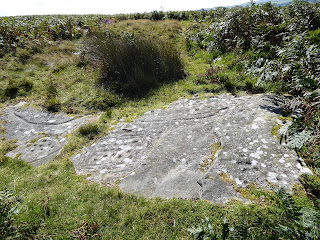In spring 2020 (pre-lockdown), BSBI's Science & Research Committee considered five grant applications. SRC grants, applications for which go live here on 1st January every year, are intended to support research aimed at enhancing knowledge of the British and Irish flora. Recipients are usually PhD students, academic or amateur researchers.
Two grants were awarded this year and, while we were quite prepared once Covid hit to put those awards on hold for a year, both recipients consulted with supervisors and came back to tell us that they would be able to carry out their planned fieldwork safely this year.
Below we hear from the first grant recipient, Dr Emma Karoune:
"With a few special health and safety measures (2m distance
or face masks for closer work, and lots of hand gel!) botanical fieldwork is
still possible, even at this difficult time. The corona virus restrictions have
not prevented the start of my fieldwork project to collect plants for a phytolith
reference collection, thanks to the support of a BSBI Science & Research grant. I had
planned to recruit a group of volunteers from local BSBI groups in Hampshire,
but I was forced to gather a select group of colleagues from the University of
Bournemouth and family members to help me get the work done. I hope that I can
continue this fieldwork next year in other coastal areas and share my
techniques with more botanical colleagues then.
The aim of my research is to develop a new innovative method
using phytolith analysis to investigate archaeological and palaeoecological
deposits. This method will add to what is already known about the exploitation
of plants by past humans and also to investigate long-term environmental and
biodiversity change. Phytoliths are microscopic silica bodies that are formed
within the cells of living plants from the uptake of soluble silica in ground
water. They can be identified to family, genus and sometimes even species
level. Their main advantage, over other archaeobotanical remains such as seeds
and pollen, is that they survive well in most conditions for thousands of years
and are therefore found in most ancient sediments. They can help to fill in
gaps when preservation of other more routinely used botanical remains are poor.

My project must start with the development of a reference
collection for the British Flora, which I am building in collaboration with
Historic England and other archaeobotanical colleagues from the University of
Bournemouth. There is very little work in this particular discipline related to
British plant taxa and therefore archaeological investigations using phytoliths
in this country are currently limited. I am starting the reference collection
by working on southern coastal plant communities at Farlington Marshes and
Eastney Beach, close to Portsmouth in Hampshire. I am concentrating on
collecting plants from saltmarsh, grazing marsh and shingle/sand dune
communities. I will expand this project next year to sample in other coastal areas
such as Poole Harbour and West Wittering/East Head to sample in these types of
plant communities again to increase the reliability of my findings and
therefore build a more robust method.
Farlington Marshes is an important site for bird breeding,
and it is popular with bird watchers but it also has interesting plants. I
selected three locations to sample that were typical of different coastal plant
communities: lower salt marsh, upper salt marsh and grazing marsh. At each
location I collected samples of the different species of plants so that I can
use them to examine the phytoliths within them to form identification criteria
for each species. I also used a 1m2 quadrat to collect the above-ground plants
and take soil samples of the topsoil so that I can examined the differences in
the overall phytolith assemblages. This will determine how to recognise each
plant community as a whole and I can work out how to distinguish each plant
community from each other so that I can then recognise them in ancient sediments.

The lower salt marsh area near the lakes and extensive reed
beds of Common reed Phragmites australis was the most difficult to sample in
terms of muddiness. We had to make sure that we were only there at low tide
otherwise we would get stuck in the mud, but it was a really special place to
work. During high tide the area nearest the lake is partially submerged and
this makes the purpley green Samphire glisten in the sun. Consequently, the
area is dominated by plant species that are used to being wet from the tidal
ingress such as Samphire Salicornia spp., Sea Purslane Atriplex portulacoides, a cord grass Spartina sp. probably Common cord grass Spartina anglica, Sea Aster Aster
tripolium, Annual Sea-blite Suaeda maritima, Lesser Sea-spurreySpergularia marina and Sea plantain Plantago maritima. There is also some Saltmarsh rush Juncus gerardii and Saltmarsh grass Puccinellia sp. in the
slightly less wet areas further from the lake.
The Point field at the south end of Farlington Marshes is an
upper salt marsh surrounded by the sea wall on three sides and bramble bushes
on the other side that leads to the grazing marsh. This area has not been
grazed for many years and is dominated by large tussocks of Creeping Bent Agrostis stolonifera and Sea Couch Elymus aethericus. There are also some wet
loving species around the edge of the field close to the stream such as Saltmarsh rush Juncus
gerardii and Sea club rush Bolboschoenus maritimus with its
beautiful star shaped inflorescence. It was very dry in this area when we
sampled but some of the birdwatchers told us that it is normally flooded and
boggy for parts of the year.

The third area sampled was the main grazing marsh. The flora
in this area was much less dominated by grasses than the Point field due to the
heavy grazing of cattle for most of the year. A. stolonifera did occur
throughout but also species indicative of a neutral grasslands with grazing such
as Crested dog’s tail Cynosurus cristatus, Red clover Trifolium pratense and Plantain Plantago sp. There were also sunken areas that I assume must
flood at wet times of the year as they contained rushes – probably Hard rush Juncus
inflexus.
I have been kindly helped with identification of the plants
collected by Tony Mundell and Martin Rand, the BSBI County Recorders for Hampshire. It is best
to collect plants in late August and September for phytolith reference
collections as this allows for the largest production of phytoliths to take
place. However, some species were more difficult to identify at this time so
still need further identification work next year. I am planning to return to
Farlington Marshes in the Spring and early Summer to collect these species when
they have floral parts.
I am currently drying and cataloguing all the plants I have
collected, and I will be spending the winter in the laboratory preparing the
samples for analysis. Hopefully, next year I can report my findings so look out
for another blogpost then.
I want to thank the BSBI for the Science & Research grant as without
this support I would not have been able to conduct this research. Thanks also
goes to Tony and Martin for their expert botanical knowledge. I could not have
completed all the sampling without my dedicated team of volunteers that
included Siggy Osbourne and Dr Sarah Elliot from the University of Bournemouth
and also my son, Akram, and my Dad, Roger. Thanks to Chris Lycett of the
Hampshire Wildlife Trust who gave me permission and help to access Farlington
Marshes. And finally, thanks to Historic England for supporting my reference
collection work.
If you want to find out more about my research and what I
will be doing next with the plants and soils that I collected, then please take a look at my poster presentation from Saturday's BSBI Exhibition Meeting".
Many thanks to Emma for telling us about her research. The images show Emma taking photos while plant collecting in the point field at
Farlington Marshes (image taken by Sarah Elliot); Siggy Osbourne (final year undergraduate) from the
University of Bournemouth putting down a quadrat in the Point field; l; lower salt marsh area near to the lakes and reed beds at
Farlington Marshes; taking soil samples from a quadrat in the lower salt marsh
area of Farlington Marshes (images 2-4 taken by Emma).





































